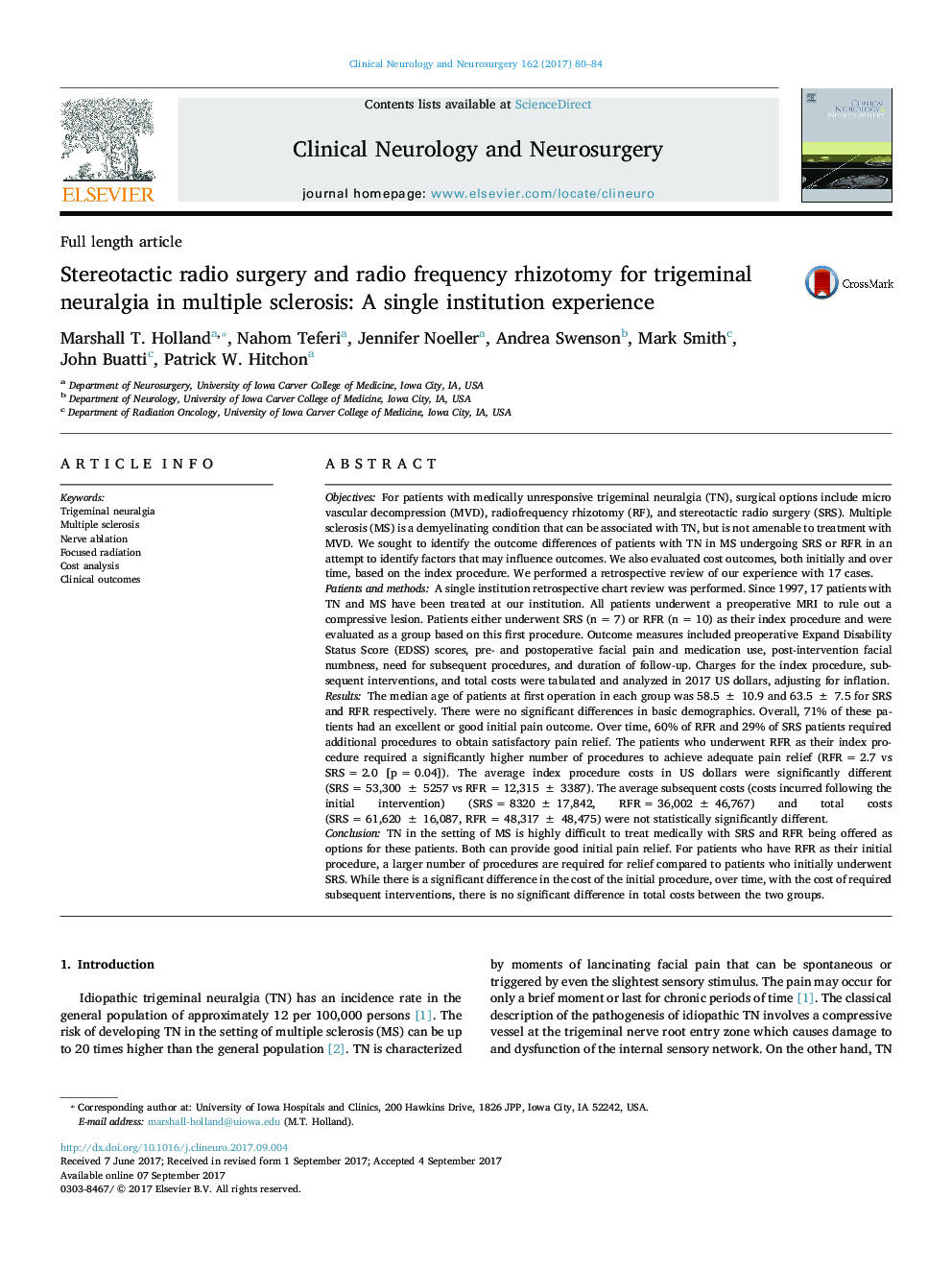| کد مقاله | کد نشریه | سال انتشار | مقاله انگلیسی | نسخه تمام متن |
|---|---|---|---|---|
| 5626923 | 1579660 | 2017 | 5 صفحه PDF | دانلود رایگان |
- Trigeminal neuralgia in Multiple Sclerosis is recurrent and very difficult to treat.
- Both radiosurgery and radiofrequency ablation provide effective pain relief.
- Patients who undergo radioablation first require more subsequent interventions.
- Index surgical cost of radiofrequency ablation and radiosurgery were different.
- Subsequent and total cost of the 2 modalities were not significantly different.
ObjectivesFor patients with medically unresponsive trigeminal neuralgia (TN), surgical options include micro vascular decompression (MVD), radiofrequency rhizotomy (RF), and stereotactic radio surgery (SRS). Multiple sclerosis (MS) is a demyelinating condition that can be associated with TN, but is not amenable to treatment with MVD. We sought to identify the outcome differences of patients with TN in MS undergoing SRS or RFR in an attempt to identify factors that may influence outcomes. We also evaluated cost outcomes, both initially and over time, based on the index procedure. We performed a retrospective review of our experience with 17 cases.Patients and methodsA single institution retrospective chart review was performed. Since 1997, 17 patients with TN and MS have been treated at our institution. All patients underwent a preoperative MRI to rule out a compressive lesion. Patients either underwent SRS (n = 7) or RFR (n = 10) as their index procedure and were evaluated as a group based on this first procedure. Outcome measures included preoperative Expand Disability Status Score (EDSS) scores, pre- and postoperative facial pain and medication use, post-intervention facial numbness, need for subsequent procedures, and duration of follow-up. Charges for the index procedure, subsequent interventions, and total costs were tabulated and analyzed in 2017 US dollars, adjusting for inflation.ResultsThe median age of patients at first operation in each group was 58.5 ± 10.9 and 63.5 ± 7.5 for SRS and RFR respectively. There were no significant differences in basic demographics. Overall, 71% of these patients had an excellent or good initial pain outcome. Over time, 60% of RFR and 29% of SRS patients required additional procedures to obtain satisfactory pain relief. The patients who underwent RFR as their index procedure required a significantly higher number of procedures to achieve adequate pain relief (RFR = 2.7 vs SRS = 2.0 [p = 0.04]). The average index procedure costs in US dollars were significantly different (SRS = 53,300 ± 5257 vs RFR = 12,315 ± 3387). The average subsequent costs (costs incurred following the initial intervention) (SRS = 8320 ± 17,842, RFR = 36,002 ± 46,767) and total costs (SRS = 61,620 ± 16,087, RFR = 48,317 ± 48,475) were not statistically significantly different.ConclusionTN in the setting of MS is highly difficult to treat medically with SRS and RFR being offered as options for these patients. Both can provide good initial pain relief. For patients who have RFR as their initial procedure, a larger number of procedures are required for relief compared to patients who initially underwent SRS. While there is a significant difference in the cost of the initial procedure, over time, with the cost of required subsequent interventions, there is no significant difference in total costs between the two groups.
Journal: Clinical Neurology and Neurosurgery - Volume 162, November 2017, Pages 80-84
